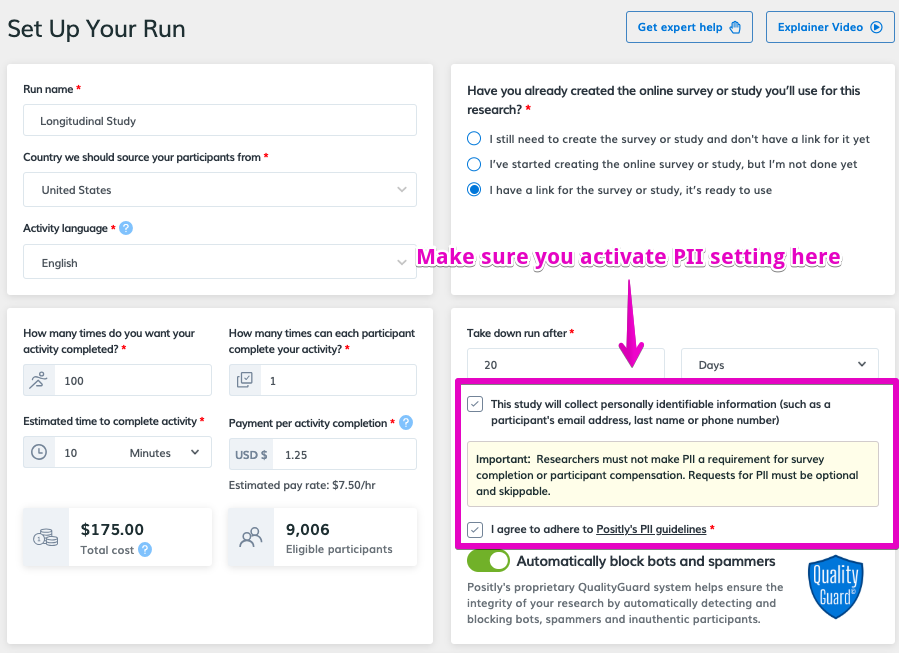Longitudinal studies are a valuable way to understand how people’s thoughts, behaviors, or conditions change over time. They allow researchers to measure the impact of interventions, track progress, or observe trends that aren’t visible in a single-session survey.
However, running a longitudinal study comes with challenges; recruiting and managing participants over multiple time points can be time-consuming and complex.
Positly offers a simple, structured way to handle this.
Why Longitudinal Studies Are Important
A longitudinal study involves collecting data from the same group of participants more than once, whether over days, weeks, months, or years. This allows researchers to measure change, rather than just capturing a snapshot.
Examples of longitudinal studies include:
- Measuring how mood or anxiety changes after using a mental health app for two weeks.
- Studying whether people change their opinions on a political topic after reading new information.
- Tracking fitness or nutrition progress across multiple check-ins.
- Observing learning outcomes before and after an educational intervention.
- Monitoring the progression of a condition over time.
Because you’re comparing results from the same people over time, you can track changes, which is not possible with a one-time survey.
Common Difficulties With Longitudinal Studies
Despite their value, longitudinal studies can be hard to run. Some of the typical challenges include:
- Finding participants willing to return for follow-up surveys.
- Tracking who completed which survey wave, especially if done manually.
- Scheduling follow-ups and managing survey links for each participant.
- Handling compensation across multiple time points.
- Collecting and storing personal contact information requires attention to privacy regulations.
How to Run a Longitudinal Study in Positly
Positly supports longitudinal studies by letting you build a recruitment pipeline, collect consent, and follow up with participants over time. Here’s how to do it:
1. Use a Standard Study to Recruit Willing Participants
Instead of running a screener, launch a normal paid study in Positly. This survey should do a few things things:
- Ask screening questions to check if participants qualify for your study (these should be collected PRIOR to mentioning that there is a longitudinal study they may qualify for, to avoid creating an incentive to lie).
- For those people who meet the screening criteria:
- Explain that the research will take place across multiple time points.
- Explain the compensation structure clearly.
- Explain any personally identifying information they will be required to give in order to enroll, such as giving their email address
- Ask these participants if they’re willing to enroll in the full longitudinal study, and if they agree, collect any necessary information such as their email address
⚠️ Email addresses are personally identifiable information (PII). Be sure to follow our PII guidelines and you must also activate the PII setting in Positly ⚠️
PII setting activation:

All participants, whether they qualify or not, should be paid the same amount for completing the initial recruitment survey. Of course, those who enroll in the longitudinal study will additionally be paid more later on.
2. Collect Email Addresses and Participant IDs
On the final page of your survey (for those who qualify AND agree to enroll), ask them to enter their email address so you can contact them later. Make sure to allow them to opt out still (such as by leaving the email field blank) in case they change their mind.
You should also collect each participant’s Positly Participant ID, which is critical for tracking and compensating participants correctly:
- You’ll need to have the Participant ID in order to track which participant does which survey; you can pass the Participant ID every time you are sending them a survey link. This way, the Participant ID data will be tagged together with their answers for that survey.
- If you’re using Positly’s Microtaskers platform, you need to have the Participant ID to send the compensation as a bonus in Positly.
Depending on the tool you’re using to host your surveys, you may need to configure it to accept and store query parameters like the Participant ID. We recommend GuidedTrack, which handles Participant ID collection by default. Other platforms may require manual setup.
Here are instructions for collecting Participant IDs with common survey tools:
You’ll now have a list of pre-screened, opt-in participants for your longitudinal study.
3. Run Your Follow-Up Surveys
Once you have your participant list, you can conduct your follow-up surveys either manually or programmatically. You can use any survey tool (GuidedTrack, Qualtrics, Google Forms, etc.) to run these surveys. GuidedTrack has a major advantage in that it can automatically send the follow-up surveys for you at the appropriate times for each study participant, and even send reminders.
Whether you use an automated approach or a manual approach, you will need to send follow-up links by email at the right time intervals. Be sure to remind participants that they’ll be compensated for their time.
4. Pay Participants
You’ll need to compensate participants for their time in the longitudinal part of your study. For instance, if you told them they would get paid only when the whole study is complete, then you would pay each participant once when they finish the study. On the other hand, if you told them you would pay them after each survey, you’ll have to do that instead. Be sure to be extremely clear to study participants (prior to them enrolling) what exactly they have to do to be eligible for payment. This is separate from the payment they received for the initial recruitment survey.
- If you use our Microtaskers platform, you can send payments as a bonus through Positly using their Participant ID.
- If you use our Panel Participants platform, you’ll need to compensate participants manually, using a third-party service like PayPal or digital gift cards.
Tips and Tricks for Running Longitudinal Studies
Running a longitudinal study requires careful planning, especially when working with online participants. Here are some practical tips to improve your study’s success and reduce common problems:
1. Run a Pilot
Before launching your full study, run a small pilot with a small number of participants. This helps you catch any bugs, confusing instructions, or logic issues in your survey flow. A pilot also gives you a chance to test:
- Whether your data is recording properly
- If email follow-ups are working
- How long each part of the study takes
- Whether participants understand what’s being asked
It’s much better to fix these issues in a test run than discover them after your full sample has gone through the process.
2. Recruit More Participants Than You Need
Drop-off is common in longitudinal research. Some participants may lose interest, miss follow-up surveys, or become unreachable. To account for this, recruit more participants than your target sample size; a 20–50% buffer is often a good starting point, depending on the length and complexity of your study.
3. Be Clear About Expectations Up Front
Tell participants how many surveys there will be, how often they’ll be contacted, and how much they’ll be paid for each part. People are more likely to stick with the study if they know what to expect. And if they don’t understand the study well enough, they may feel cheated when they realize what they have to do or don’t get the payment they expected. If you decide not to pay participants who drop out early, or if you offer partial payment for partial completions, state this clearly in the first survey.
4. Use Reminders Strategically
For longer studies, a reminder email or two can significantly improve completion rates. You can include calendar invites, set up scheduled email follow-ups, or send short updates between waves to keep participants engaged.
5. Make Follow-Ups Quick and Easy
The more time it takes to complete your follow-up surveys, the more likely participants are to abandon them. Try to keep each follow-up short and to the point; 5–10 minutes is ideal unless you’ve clearly explained otherwise in advance.
6. Track Participant Status
If you are contacting participants manually, keep a simple spreadsheet or system to track who has completed each wave and who has been paid. This will help you know who to follow up with and who to include in the final compensation.
7. Make Compensation Fair and Transparent
Decide ahead of time how you’ll handle participants who:
- Complete all waves
- Only complete the first few
- Sign up, but never respond again
It is usually wise to allow some leniency, so that if participants complete most but not all of the surveys, they can still collect at least partial payment. But communication is key: it’s critical that participants know what they are agreeing to.
These small steps can help prevent common pitfalls and increase your chances of collecting clean, consistent data throughout your study. Longitudinal research is complex, but with careful preparation and the right tools, it’s very doable.
Fully Managed Longitudinal Studies (Optional)
If you’d rather not handle all the setup yourself, Positly offers a fully managed service. We can help with:
- Writing your screener and main surveys
- Programming and testing your study
- Recruiting and qualifying participants
- Distributing compensation across time points
Our team will work with you to make sure your study runs smoothly from start to finish.
Final Notes
Longitudinal studies can offer deeper insights than one-time surveys, but they also come with more complexity. With Positly, you can recruit qualified participants, follow up easily, and pay them reliably, without having to build a custom infrastructure from scratch.
If you’re planning a multi-wave study and you want to make sure it runs well, feel free to reach out. We’re happy to help.
Bonus Tip: Automate Your Longitudinal Study with GuidedTrack
If you’re looking for a way to help automate the flow of your longitudinal study, GuidedTrack is a great tool to consider. It allows you to:
- Program surveys that can behave differently depending on the situation (e.g., daily check-ins or weekly updates)
- Automatically email participants survey links at scheduled intervals to avoid complex manual work
- Customize each message and experience based on previous answers
A Practical Tip for Using GuidedTrack
When sending out survey links, always include the participant’s ID or email address in the URL as a query parameter (e.g., ?id=ABC123). This lets you identify who submitted each response later on.
Otherwise, you might end up with a complete dataset, but no way to know who completed what, which can create major issues for analysis and compensation.


